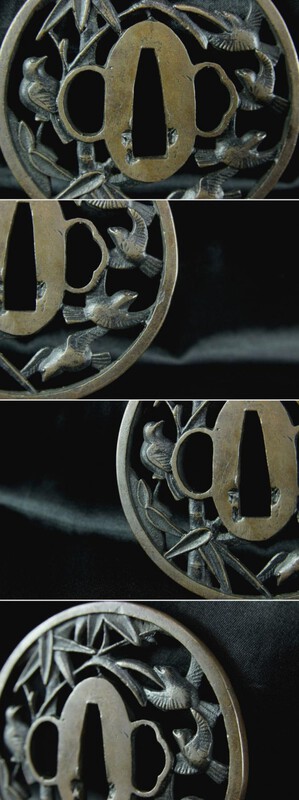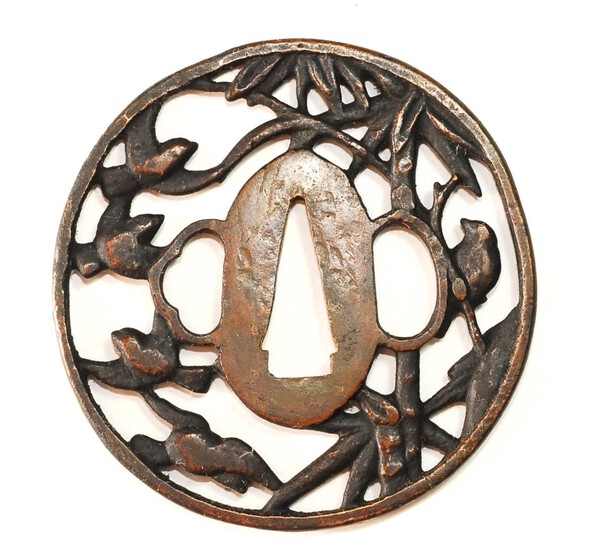
Lilleskit
Members-
Posts
17 -
Joined
-
Last visited
Content Type
Profiles
Forums
Events
Store
Downloads
Gallery
Everything posted by Lilleskit
-
Hello and thank you. Your correct that there were numerous smiths using the name Kanemichi and right about the similarities in some of their mei as well. Your right in saying that "gimei" shouldn't be used without verification, it was careless to say so without knowing. I'm uncertain which is why I'm asking. That said, I've found seven Kanemichi that were active from Murimachi and into the edo period and it would be a pleasant surprise if it turned out to be authentic. So far, all of the mei I've studied have, like the example given, been off in spacing, and/or stroke direction, as well as depth. Some signatures match one character perfectly but are way off on another. I've tried to upload better pictures och the blade but the file exceeds the allowed max. I'll try editing the and upload them tomorrow. For now, here are smaller images of the ura side.
-
Hi all, I'm working on a ebay blade bought from a U.S. antique seller. The blade, imo, is definately gimei but worth rescuing. I couldn't uppload all the pictures so I attached a PDF I through together. It's the same as the info shown below but with pics if anyone is interested in helping. Any insight would be appreciated. Thanks Sword Overview: Blade Type: Handachi (I believe it’s originally a tachi, now shortened and fitted as a handachi) Nagasa: 69 cm Nakago: 19.5 cm Sori: 0.67 cm Kissaki Length: 3 cm Width: Base - 2.93 cm, Middle - 2.64 cm, Tip - 1.94 cm Thickness: Base - 0.74 cm, Middle - 0.65 cm, Tip - 0.54 cm Original blade likely had a deeper sori before shortening Polishing Work and Observations: Polishing performed entirely on hazuya stone and finger stones (hazuya and jizuya) Surface cleaned of minor pitting and small chips Nugui applied in stages to enhance contrast Hada observed: Combination of masame and itame Kissaki and Boshi: Evidence of historical reshaping (likely due to prior damage) Boshi appears to be kaen-style (flame-like?), subtly different on omote and ura sides Kissaki being refined slowly to avoid over-thinning Mei and Nakago: Mei, signed Tango No Kami Kanemichi is likely gimei or optimistically, ato-mei, based on both carving quality and inappropriate placement (katana side of a shortened tachi). Also, if not gimei, it would mean my era guess is off by about a century. File marks include oosugikai on original nakago, katte-sagari on new nakago area Hamon features include: Notare and ko-gunome base. Sudareba sections (bamboo-blind pattern). Choji-midare elements. Sunagashi and dense nie School possibilities: Soshu? strong candidate based on nie and sunagashi Bizen? possible influence (choji, sudareba) Mihara or Yamashiro? structurally plausible but less likely Era Estimation: Based on sugata, nakago condition, and hamon activity, can the blade date back to the mid-to-late Muromachi period? Assumption based on the thin kasane, tapering mihaba, o-suriage nakago, and variety of mixed hamon elements Structural Notes: Blade remains straight and healthy but tired Two kirikomi-kizu (I think) found and left untouched due to possible historical relevance Koshirae and Mounting: All non-metal fittings and stand made/fitted from scratch, wood, samegawa, and silk ito imported from Japan Saya and stand built from honoki. Unknown wood species for the tsuka but likely old pine I had lying around. Full samegawa wrap on both tsuka and upper portion of the saya Tsuka-maki is tight and secure using high-quality ito Menuki are centered per tachi tradition Edo era tsuba is very secure when the menuki is in place Brass fuchi and kashira and saya fittings are reproductions, aged using vinegar and egg method Vertical tachi-style display, edge facing inward, tsuka downward Saya is snug and secure, with careful shaping to match the blade and habaki geometry Silk sageo dyed to compliment tsuka-ito with typical display knot. Goals: To restore and preserve the blade without altering the geometry of it’s pre-polish condition to a point that school, age, and hopefully smith identification is possible. Same Information with pictures in the attached PDF Handachi Summary apr 14.pdf
-
I uncertain if it is meant to be wisteria. I was thinking possibly kikyo (桔梗, bellflower) or possibly tachibana (wild citrus blossom)🤔
-
Great info all😎👍🏼 It's very appreciated 👏
-
Very much appreciate your response 🙏🏽 I'm guessing mid edo but unsure. Yhe inlay seems edo but the robust iron construction even for yhis little tsuba has me wondering if it could have an earlier origin.
-
How does one tell if a naginata-naoshi (naginata remounted or reshaped into a tanto or wakizashi) is a true naginata-naoshi or just a wakizashi or tanto forged in the shape of a cut down naginata?
-
Hello all, Could anyone with more knowledge than me on tsuba types and history (which is just about everyone) help me with this tanto tsuba. I've been unable to find other examples like it. It's well constructed sitting perfectly without any rattle when seated. It measures 5cm x 3.3cm. I liked the design of it and needed it for a project I'm working on but I want to learn more about it. Any information would be helpful. Thanks, Ken
-
Hello all, Could anyone with more knowledge than me on tsuba types and history (which is just about everyone) help me with this tanto tsuba. I'm assuming it's from the mid to late edo period based on the inlay work but the no nonsense construction says early edo or slightly earlier. It's well constructed sitting perfectly without and rattle when seated. It measures 5cm x 3.3cm. Some of you have probably seem it on ebay. I liked the design of it and needed it for a project I'm working on but I want to learn more about it. Thanks for forgiving my ignorance 🫠 Ken
-
- 1
-

-
Hello! I'm looking for advice/tips on shipping my swords from Europe to the states. It sounds and seems like it should be as simple as boxing them up and sending them home but I don't want to miss anything. Has anyone come across any issues with customs? Are there possible problems sending by air etc etc? Thanks in advance!
-
Hey Jason! I did a test buy from them and it went fine. The "restricted" items are quickly unblocked at the interested parties request and if not they will unblock the item in question after a short "Please unblock this item anyway" email from you provided you accept responsibility for possible import problems into the country. From purchase to delivery was a little slow. I bought tsuba and it took approx three weeks to arrive. As said, a little slow but the information on their site showing where you item is in the shipping process was quite good. Hope that helps!
-
Hey Kemlos! If you're interested there's a page here with some of the basics on how to recognize a lot of the fake antiques that are out there. It can be found at the top of this page under the heading Research ==> Fake Swords. Sorry for you loss. /Ken
-
Antique Tsuba And His Faked Twin Or Two Fakes?
Lilleskit replied to Lilleskit's topic in Auctions and Online Sales or Sellers
Hey! Sorry for the lack of information about the pictures. Yes there are three pictures showing 2 tsuba identical i form but not quality. The multi image on the far left appears to be a much better (original?) version of the following two pictures showing the omote and ura side of the lesser quality tsuba. -
Hello everyone! I was googling today and found these two tsuba attached to two separate auction sites. The one of lesser quality was on Ebay with a starting bid close to $100 if i'm not mistaken (no one fell for it, 0 Bids). I'm wondering if there is any chance that the other could possibly be "real" or are they both just production fakes. Thanks for any opinions! Ken
-
Ian, Thanks for that. I'll check into that family. Yes, your right. The 6 coin mon is the one used by the Sanada clan. The leaf mon is the one that's killing me. I believe that is was dictated that lower ranking soldiers were required to have only simple furnishings on a katana. The kashira was expected to be plain or possibly a simple grain pattern if I recall. The fuchi was also relatively plain with only the kamon of the clan they were fighting under. It was howerver accepted the on the reverse side that soldiers own family crest could also be displayed. That could result in two different crests with no other connection other than that they were all playing for the same team. Please correct me if I'm wrong.
-
Hey Brian! I just looked at the mon you found used by the Matsuura clan and am wondering if it can be the same. Can a mon with a identical image be seen as completely different by placing it in a circle and can even the thickness of the circle come into play as well? I would love to think that this is the mon from the Matsuura clan and that I can let my brain rest a bit but...
-
Hello again. Thanks Brian for that information. It's true that this may have come from a sword whose owner or family would not have made even the slightest blip on histories radar for all the reasons you've listed. Here are a few pics. (sorry for the poor quality) Thanks!!! Ken B. P.S. Feel free to mock me if this turns out to be a fake. :D
-
Hello all! First I'd like to warn that I'm new and hope that I'm not posting in the wrong place and that I wish I had found this board years ago (before a few embarrassing purchases). I recently bought a fuchi on ebay but I'm having trouble tracking down information on the the item, bid time ran out before I could come to any solid conclusion. Historically it seem to comply with the limitations of a lower ranking soldier (I think) but that doesn't necessarily mean anything. On the one side there is a Sanada crest and on the other is a family crest I've been unable to track down. I though it might help me determine the age and possible authenticity if any affiliation between Sanada and the other family was at all possible. The crest type when translated on the "BABLE FISH" website is "Leaf of Abe rudder" and can be seen second down on the left at: http://www.otomiya.com/kamon/plant/kaji.htm Any thoughts would be greatly appreciated. _______ Ken B.









